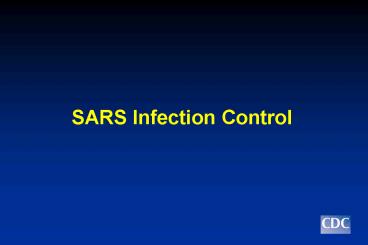SARS Infection Control - PowerPoint PPT Presentation
1 / 22
Title:
SARS Infection Control
Description:
Wear a surgical mask when in the presence of other household members ... How will they get food and other supplies (e.g., surgical masks) ... – PowerPoint PPT presentation
Number of Views:58
Avg rating:3.0/5.0
Title: SARS Infection Control
1
SARS Infection Control
2
SARS Infection Control
- Key Objectives
- Early detection
- Containment of infection
- Protection of personnel and the environment of
care - Hand hygiene
- Key Strategies
- Administrative measures
- Infection precautions
- Standard
- Contact (droplet)
- Airborne
- Environmental cleaning/disinfection
3
SARS Transmission During Aerosol-Generating
Procedures
- Transmission of SARS to healthcare personnel
during aerosol-generating procedures may be
particularly efficient - Clusters detected in Toronto, Hong Kong,
Singapore and Hanoi - Intubation, suctioning and nebulization
specifically implicated
4
Why? How?
- Patient infectivity higher?
- Is it Droplet? Contact? Airborne?
- Is it failure to wear protective equipment?
- Is it failure of protective equipment?
5
Until Risks During Aerosol-Generating Procedures
Better Defined..
- Limit cough-inducing procedures
- Avoid use of non-invasive positive pressure
ventilation (e.g., CPAP, BiPAP) - Protect the environment
- Use closed suctioning devices
- HEPA filtration on exhalation valve port
6
Protect Healthcare Personnel DuringAerosol-Generat
ing Procedures
- Limit personnel to those essential for performing
procedure - Wear appropriate personal protective equipment
- Gowns and gloves
- Sealed eye protection (i.e., goggles)
- Respiratory protection device
7
Respiratory Protection During Aerosol-Generating
Procedures
- Proper fit is essential
- Reassess respirator fit among personnel who may
be involved in intubation of SARS patients - Consider better fitting respiratory protection
devices - Disposable respirators with better seal, e.g.,
N99, N100 - Half- or full-face elastomeric (rubber)
- Powered air-purifying respirators (PAPR)
8
Management of SARS Exposures in Healthcare
Settings
- Surveillance of healthcare personnel
- Develop list of personnel who have contact with
SARS patients (I.e., enter room, participate in
care) - Encourage reporting of unprotected exposures
- Monitor absenteeism for SARS-like illness
- Management of asymptomatic exposed HCWs
9
Management of Asymptomatic Exposed Healthcare
Workers
- No evidence of transmission from asymptomatic
persons - Symptomatic HCWs have transmitted
- Active surveillance of HCWs who have unprotected
exposure is recommended - Monitor temperature and symptoms before reporting
to duty - Ten-day exclusion from duty for HCWs who have
unprotected exposures during aerosol-generating
procedures
10
Addressing the limited supply of respirators
- Should respirators be reused?
- Disposal after one-time use preferred
- Use up higher level respirators first
- Reuse preferred to no respirator
- Consider using surgical mask to protect
respirator from contact with respiratory droplets - Carefully handle contaminated respirator
- Use surgical masks only when respirators are
unavailable
11
Cleaning and Disinfection of the SARS Patient
Environment
- Environment may be a key to transmission
- Clean/disinfect frequently touched surfaces daily
in in-patient areas - Bed rails, over-bed table, door knobs, lavatory
surfaces - Perform more thorough cleaning at transfer or
discharge - Use EPA-registered hospital detergent
disinfectant - No need for air fogging or washing of ceilings
and walls
12
Management of Exposed and Symptomatic Persons
13
Infection Control Principles Applied in the Home
- Early detection of infection
- Containment of infection
- Protection of household members
- Limiting contamination in the home environment
14
Key Time Periods
- 10 days after last exposure
- Duration of post-exposure monitoring period
- 72 hour rule
- Period for reassessing early symptoms of SARS
- 10 days after resolution of fever
- Duration of post-SARS confinement
15
Guidance for Persons Exposed to SARS
- Asymptomatic exposed persons
- No change in daily activities
- Monitor for respiratory symptoms and fever (i.e.,
measure temperature twice daily) for 10 days
after last exposure - Fever or respiratory symptoms develop
- Notify healthcare provider
- Limit interactions outside the home
- Reassess in 72 hours
16
72 Hour Reassessment
17
Infection Control for Persons with SARS
- Avoid interactions outside the home (school,
work, day care, church, shopping) - Wear surgical mask and avoid public
transportation if travel outside home is
necessary - Limit persons coming into the home
Including persons who have not been diagnosed
with SARS but have SARS symptoms
18
Infection Control Advice to SARS Patients
- Wear a surgical mask when in the presence of
other household members - Contain respiratory secretions in facial tissue
and place in lined container for disposal with
household waste - Perform hand hygiene frequently and especially
after touching respiratory secretions and other
body fluids (e.g., urine, stool)
19
Advice to Household Members of SARS Patients
- Wear surgical mask when around SARS patient (if
patient cannot wear mask) - Perform hand hygiene frequently (hand washing
with soap and water or use of alcohol-base gel) - Consider wearing disposable gloves for direct
contact with body fluids of SARS patients
20
Other Infection Control Measures in the Home
- Do not share personal items until thoroughly
washed with soap and water (towels, linen, eating
utensils) - Consider separate sleeping arrangements
- Clean surfaces that are touched frequently or
come into contact with body fluids (e.g., food
preparation areas, phones, lavatories)
21
Anticipatory Guidance for SARS Patients
- How will they get food and other supplies (e.g.,
surgical masks)? - How will they travel to and from necessary
appointments (e.g., medical) - How will they deal with family members who are
afraid?
22
Prevention is Primary!































